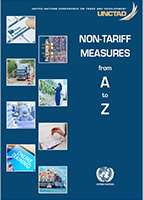
Trade-related regulations such as product and production requirements, as well as conformity assessments, are increasingly shaping trade by influencing who trades what and how much. For policymakers, importers and exporters, such non-tariff measures (NTMs) represent a major challenge. Many NTMs are primarily aimed at protecting public health or safety or the environment, yet they also substantially affect trade through informational, compliance-related and procedural costs.
NTMs are policy measures other than ordinary customs tariffs that can potentially have an economic effect on
international trade in goods, changing quantities traded or prices or both.
This neutral definition does not make judgments on the legitimacy of the measures nor the direction of their potential impact on trade. NTMs may decrease trade, for example, when trade costs increase or may increase trade, for example, when trust in foreign products increases. The concept comprises a wide area of policy measures.
Two broad categories may be distinguished:
-
Traditional policy measures such as quotas and price control measures, which are generally intended to impact trade.
-
Technical measures that mostly aim to protect health, safety and the environment, notably sanitary and phytosanitary (SPS) measures and technical barriers to trade (TBT).
Many regulatory NTMs are indispensable for sustainable development. Non-tariff barriers are a subgroup of NTMs that have a protectionist intent or are more restrictive than necessary to achieve public policy objectives.
Understanding the uses and implications of NTMs is essential in the formulation of effective development strategies to achieve the Sustainable Development Goals. Increasing transparency and the understanding of NTMs can help traders identify the requirements they face and build the capacity of policymakers, trade negotiators and researchers to achieve a balance between the reduction of trade costs and the preservation of public objectives.
This compendium provides an overview of global transparency efforts, including with regard to the international classification of NTMs, data collection and data dissemination, as well as approaches to achieving good regulations, including recent research results and analysis tools, social implications such as gender-related and environmental effects, a toolkit to assess cost effectiveness and NTMs and the online academy on NTMs. Each chapter provides highlights from the work of UNCTAD and references for further reading.





